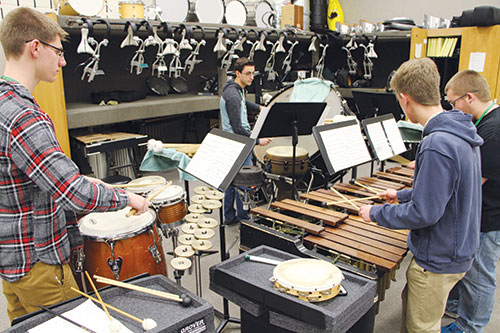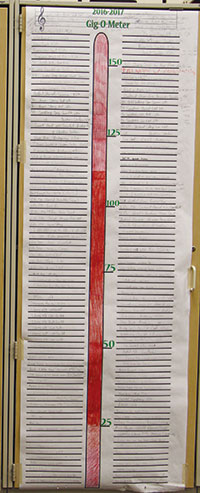“There is a sense of purpose and extraordinary engagement when students can see that their music has a destination beyond just another performance here at school.”
Several years ago, I took a group of brass players to play Christmas carols at a local assisted living facility. After we finished, a man came up and explained that he was a retired educator who had taught high school for 40 years. He told the students he was so glad that they had come on a Saturday morning, and as a former teacher, he knew how significant it was to give up their time. He said that his wife had recently had a stroke and lost the ability to speak, but he looked over at her while the students were playing and could tell she enjoyed the music immensely. The man had tears in his eyes, and his story moved us to tears as well. One of the students would later reflect in a college essay, “At that moment it didn’t matter that I had gotten up early on a Saturday morning in the middle of winter to play for people I didn’t know. It felt so incredible to affect someone in that way and to know that I had made a difference.”
My school has had a chamber music program for decades. Students would pick a piece, practice in small groups for about five weeks, and then perform it at a chamber ensemble concert. However, it didn’t matter how much I preached about the virtues of small ensemble playing. Interest and engagement were low. Playing at the nursing home flipped a switch for me. There is a sense of purpose and extraordinary levels of engagement when students can see that their music has a destination beyond just another performance here at school. Defining a gig as any sort of outreach beyond the walls of our school, in fall of 2015 I challenged students to play 100 chamber gigs by the end of the school year. We created a chart in the band room to keep track of the number. I explained that two or more performances in the community by any group, would entitle that group to participate in a celebration at the end of the year – if the challenge of a hundred gigs was accomplished. That first year we almost made it to 130. Last year we set it at 150 and surpassed it by 15-20. This year we’re shooting for 175 just to see what happens.

Gigs First
You don’t start a chamber program by breaking students into groups, having them rehearse, and then telling them you will find them a gig when they are ready. Start with the gig. Go to the nursing home and ask if you could work out some dates to play if you got a group of students together. Settle on a few dates and take them back to the students. Say you have a nursing home that would love for students to perform and ask who is interested. You need a destination for your art first. That establishes a sense of purpose. Once you have that date in place, everything else falls in line. Decide how much music is needed and what to prepare, then start with the easiest pieces. Suddenly, students are moving along and starting to feel solid as a group, and they have the confidence to tackle a more difficult piece.
I do much of the legwork in lining up performances, but we are starting to see students line up gigs at a church party or a grandparent’s retirement home. When I find an opportunity for students, I announce the gig information in rehearsal and ask who is available. I have found that it is important to frame the request as if it comes from the outside organization and not me. If I am just the messenger, relaying information regarding a special performance opportunity, students see it as a grown-up activity – a professional gig.
Once students played for a group of seniors, people at a homeless shelter, or patients at a stroke recovery center, they saw how what they were playing made a tremendous difference in their audience’s day. That sort of purpose reorients the entire process.
Setting a gig for a group now means that they have a sense of urgency for their rehearsals. They know they have 15-20 minutes of music to prepare. That type of autonomy strengthens that sense of purpose even more. The end result is that engagement is enhanced. There is nothing like a gig to motivate you in the practice room. That’s a big part of why we’ve seen success.
When offering gigs, aim for the Goldilocks effect: gigs that do not cause too much anxiety, the way playing in front of thousands of people might feel, but not gigs that feel like a joke. This use of just the right amount of anxiety is where the real magic happens. The gentle pressure during the performance, which stems from the vulnerability that is inherent to one-on-a-part chamber playing, is the key ingredient in building bonds of trust and interdependence between the students. I’ve watched students celebrate with a fist bump after they’ve navigated a difficult piece of music at a gig and seen them celebrate with knowing smiles and head nods to each other after they self-corrected a missed entrance within the music.
One of my favorite stories happened watching a woodwind quartet playing a gig at a coffee house. I sat in the back with a cup of coffee and noticed that the bassoonist got entirely lost. I was curious to see what would happen. I could see their nervous glances, but they didn’t stop. At the right moment, the clarinetist lifted her bell and dropped it down at a rehearsal mark, and they were back together. This culture doesn’t designate a leader but allows leaders to emerge when needed. This interdependence, trust, and shared sense of purpose is the stuff that great organizations are made of. We are just beginning to reap the remarkable benefits of these experiences.
We started a monthly chamber ensemble concert at our local library and are getting crowds of about 100. Students come to listen to and play for each other. Experienced chamber music players are the best audience member; they know how it feels to be that vulnerable in an exposed performance. They are listening, appreciating, and then celebrating with each other afterward.
Getting our percussion ensemble out has been the most difficult part. The best choice for them so far has been going to middle schools, where there is equipment they can use. We are purchasing a set of singing bowls and investigating options for using percussionists with music therapy.

Picking Music
Younger students work on music that I pick for them, and we have gig books students can use to select music. The gig books came together through trial and error. There are magical tunes that students connect with right away. That is important; there has to be an initial sense of accomplishment. At first, the goal is to get students excited about chamber music. Later, we can work toward the finest pieces available.
There is a chasm in literature for this age group. Chamber music collections seemed to be more common 60 years ago, and similar volumes are difficult to find today. We would like to commission some music, and I keep my ear to the ground about new chamber pieces. I would love to see the community of composers put their creative spin on clever entry-level chamber music.
As students move into their junior and senior years, music selection diversifies more. Some students are content to work on what I give them, and others start buying or even writing their own music. When I told these groups that I would be glad to purchase new music for them, they responded that they wanted exclusive rights over their music – they wanted to build their own library of tunes. A couple of our top groups receive outside coaching, and these coaches also assign music. The top woodwind quintet is transcribing a piece it hopes to publish.
Before changing my approach, I would preach and coach endlessly, as though everything musical needed to flow through me as a director. That is limiting. Now, students make their own decisions, because they are responsible for preparing for coming gigs.
Rehearsing
We have weekly chamber music days. Sacrificing one full band rehearsal a week for our ninth grade and middle concert band and two days a week for our top symphonic band has been more than worth it. Everything is better. Students see themselves as collaborators rather than just fifth chair clarinet, for example. They gain a sense of their role in the full ensemble. Full band rehearsals are more efficient because students are more aware of subtle differences in phrasing and articulation and have a better understanding of how to listen for the active lines within the music. The sense of internal pulse is better because students learn that in a small group they are completely responsible for pulse. Their understanding of how to watch for non-verbal cues means that I can talk less and conduct more. Chamber music makes that much of a difference.
Students in chamber groups with a gig already on the calendar feel accountable to the music on the page and the people around them. They have gained a sense of putting their own stamp on the music and have dramatic control over how it sounds – style, volume, and nuance. Students realize how connected to that they are through chamber music. They listen more and learn how to communicate nonverbally within the ensemble. You do not get that in the practice room. It comes from playing in front of an audience that generates the potential for that to happen.
This accountability is especially valuable for students who play bass instruments. In a chamber ensemble, a bass clarinetist cannot hide the way he might in full band. The sound has to be present and strong to support the group. In one of my saxophone quartets, our bari player hasn’t been as engaged as he used to be. He is a good player but doesn’t especially care for playing bari. One day last fall, I talked with this quartet extensively about movement and communication. I told the quartet members that I didn’t care how they moved, as long as they moved. This bari player is the most extroverted of the group and was the first to start to move. Suddenly, everything changed. He discovered the potential for his instrument’s voice to change everything about the quartet’s sound. Sometimes a chamber music experience helps low wind players to see just how much power their sound has. Admittedly, it happened by accident, but that activity caused a profound change in that student’s thinking about what he could do on that horn.
I have found that it is important to do as little coaching as necessary at first. Matthew May, in his book In Pursuit of Elegance: Why the Best Ideas Have Something Missing, frames this engagement technique as if you are asking someone to finish a jigsaw puzzle for you. If you do too much of the puzzle for them, the task will seem too simple and the engagement will be inhibited. If you do too little of the puzzle, the task may seem overwhelming – and again, the engagement levels will be inhibited. Your goal is to help or coach just enough to inspire and facilitate the elements needed for achieving the goal without squelching the natural autonomy that you want to happen within the group. Your job is to make sure the goal is clear, it seems achievable and yet leave an element of mystery as to how the goal will be accomplished. Specifically, the process consists of giving students a picture of how the gig will look, providing appropriate music as a resource, and setting up a space and time for students to fill in the gaps.
As I walk around between the different chamber groups on small ensemble day, I most commonly tell students to trust themselves. Play out. Take chances. Move. To really understand the value of unspoken communication you have to move. Students also have to teach themselves to start together. It is common to hear freshman groups start a piece in rehearsal with someone counting up to three or four measures out loud. It takes practice to progress to starting by just taking a breath together.
Conclusion
Directors can get hung up on the notion that students are not ready to perform. Let them go out anyway. One of my favorite quotes is “Artists stop being artists when they lose a destination for their work.” If they go out and the performance does not go as well as they want it to, that rings a warning bell in a way that a teacher could never do. It sets up a series of priorities for them when they go back to the practice room. You have to be okay with members of your program going out and being less stellar than you would like. That struggling is part of learning.
Students in a chamber ensemble know that they are in charge of their own music making. They don’t need a director to line anything up. Students can learn how to select music, organize a gig, and lead a rehearsal. They know the difference it can make.
The Students’ Take On Chamber Music
We interviewed a number of students in the York High School band program for their thoughts on playing chamber music and the 100-Gig Challenge. Here are their responses.
What are your favorite things about playing chamber music?
With chamber music, whatever you put in is what you get out of it. If you make the effort to be available for gigs and set up time to practice after school, it is really fulfilling when it works out, because you know you set it up and put it together. It is a good feeling.
My favorite part is the experience of performing for people in public and playing with friends. We develop relationships as a group, and it is enjoyable and addicting. I don’t think there are any cons to it, because everyone gets to hear music, and we get to enjoy our time together.
It is nice to know that it’s just you and three or four other people making this music. You aren’t lost in a large band; there are just a few of you.
How has playing in a chamber ensemble improved your musicianship?
There is another quintet that has been together for two years now, and they are a role model for the entire band. They were talking about how they write each other’s names in the music so they know who to listen for or highlight. We started doing that too, and it has helped us a lot. We now know who should be featured at any moment, and if we get lost we use each other’s names in our music to get back on track.
I have more confidence. In full band you don’t hear yourself that much, but in a chamber group you have to hear yourself, because you’re the only one on your part. You are forced to gain confidence.
Chamber music teaches you to hear instruments that aren’t yours. Playing with a horn, trombone, and tuba has made me more aware of what those instruments do in a large ensemble. I think more about how these instruments fit together in a large group.
I considered solo playing and band to be different because in band I had to focus on hiding my sound within everyone else’s. I entered this small group with that mindset that I still needed to hide, but with this group I can combine both mentalities and be both a soloist and a group player. This is a valuable thing to learn.
I used to drown out other players. I was self-centered. Working with my chamber group and seeing what can happen when you interact with each other for the sake of the music has made me realize how important it is to listen to others and think of more than just yourself.
Joining a chamber group forced my to confront my stage fright. We rehearse three days a week, and my first year in the quartet was a struggle. It forced me to build confidence and ignore that part of myself that tells me other people shouldn’t hear me play and that everyone else will judge me.
I internalize time more, both in my small group and in full band. Obviously, you still watch the director in band, but you also listen to your part and learn where it should match up. It gives you a better sense of your part.
What is the biggest lesson you’ve learned from playing chamber music?
We have only been together a short time, but we have learned that in small groups you have much more responsibility. It pushes you to be work harder, which makes you into a better player.
Chamber music gives you a good picture of who you are as a musician because it exposes you a lot as an individual player. You pick up on many aspects of your playing that need improvement that you might never have noticed playing in a large ensemble or practicing on your own.
It is easy to be complacent in a big section and think that you just have to follow the person who is in front of you, but as the only person on my part in a chamber group there is a lot more responsibility on me to do things with the dynamics so it’s interesting. In full band it was easy to let the first chair player choose dynamics and then just follow them. Now I’m the first chair player because I’m the only one on my part.
You learn to pay attention to the little details. If I am running through a passage I really listen to my intonation. That’s something we pay attention to in the small group because of how much one out-of-tune player can stick out.
We started on simple pieces but realized that we weren’t going to get anything out of it until we put something into it. We had pieces that seemed simple, but after running them we realized that chamber music could be fun and these pieces could sound great if we all put in the energy the piece needed.
What is your favorite story from a gig?
When we played a jazzy piece, one of the women in the audience started dancing and got a lot of other people to start dancing with her.
My freshman year I played a duet gig with another flutist, and a woman started crying in the middle of our performance. My first thought was to wonder if we were really that bad, but afterward she came up to us and told us that our music reminded her of when her son used to play his trumpet and it touched her.
We were at a farm, and we could not find our performance spot.
There are always jitters before a performance, but the assisted living center was a great place for a first gig because the residents were so appreciative. It was a comfortable place to grow as a group of players.
We were a little underprepared for a gig at a library, but we played, and that’s the good part.
We got to meet a lot of the residents of an assisted living facility. Hearing us play carols for them made some of them really emotional. You could see how happy they were. They passed out bells for when we played jingle bells, and one man in particular seemed so happy to be able to play along. It warmed my heart.
Many people mistake my bassoon for an oboe.
We had the opportunity to play for a formal dinner at a house in Chicago. We got to perform for people who had never met us. Usually we play for friends and family, so that was our first serious gig. We were treated like professionals, so it was really special.
I had my first experience of packing up my drumset, loading it into my car, and driving to Chicago for a gig. People were there to hear good music and were appreciative.
I had a man come up to me afterward and express admiration because he had heard the horn was a difficult instrument to learn. His last words to me were “I guess you did good.”
During one gig, while playing we forgot the audience was there and were focused on playing for each other. It was an amazing experience. Music is at its most honest when you’re making it with people you care about.
How has playing chamber music changed your future plans?
When I was a freshman and sophomore, I was opposed to majoring in music education, probably because both my parents were music teachers. With our quintet, we choose our music, which is a game changer because we choose music we love to play. We learn it to the point that we have it memorized, which lets us be engaged with each other and focused on combining our sounds into one. It makes me happy, and I realized that if I was learning this, I wanted other people to learn it, too. It changed things for me. I’ve always loved working with kids, and now I want to do that for a living so I can show people they can take control of their music and their own path in music rather than always following what the band director says. It’s great to have your own take on it.






